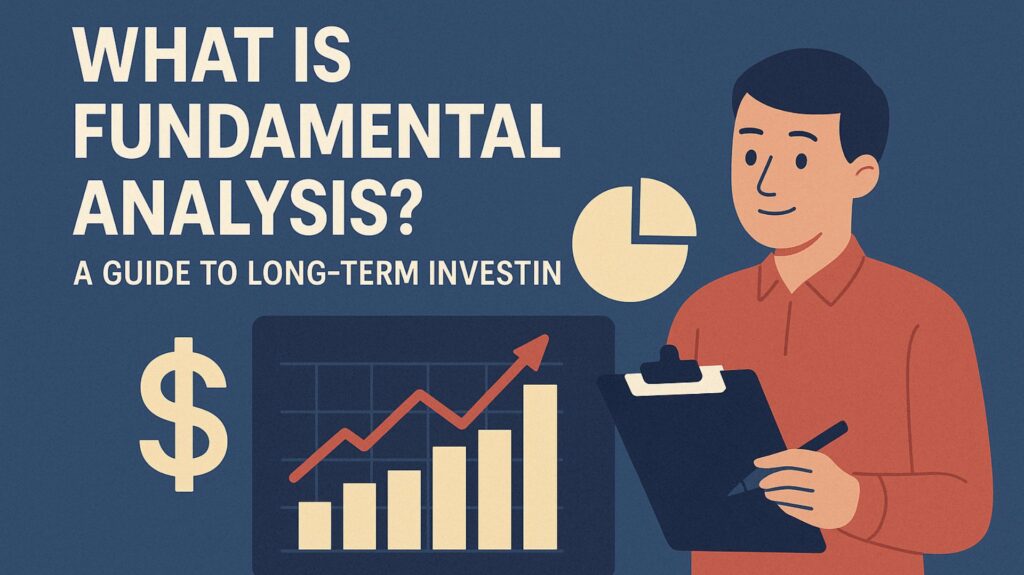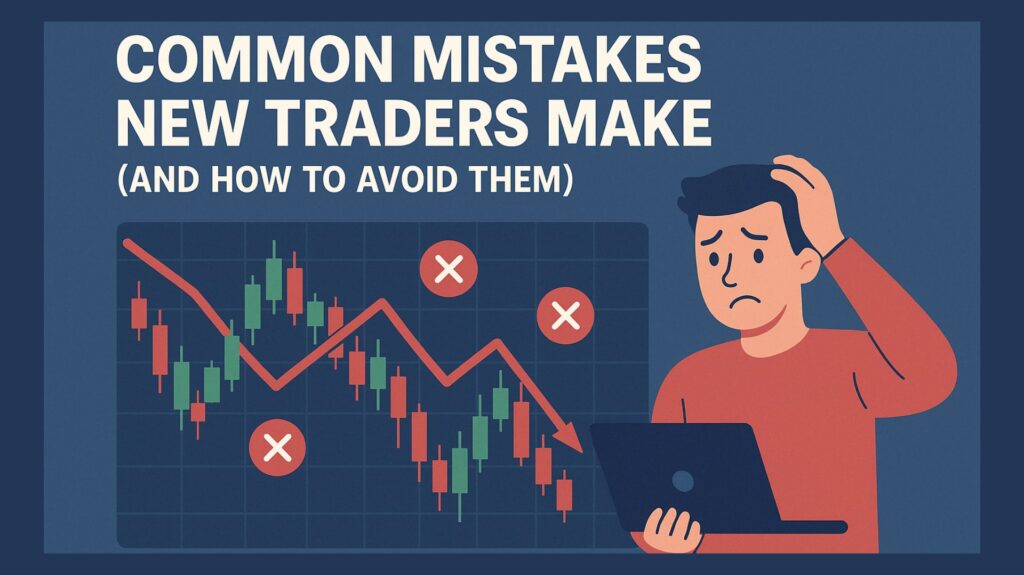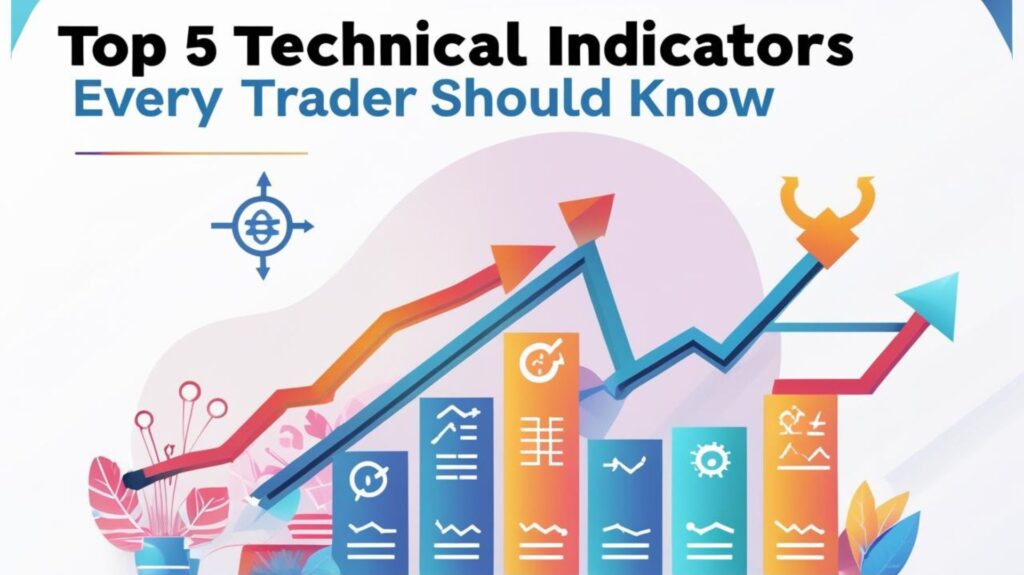What is Fundamental Analysis? A Guide to Long-Term Investing

Blog Details When it comes to building wealth in the stock market, successful investors don’t rely on luck. They rely on research, analysis, and strategy — and at the heart of that strategy lies fundamental analysis. Whether you’re a beginner planning your first investment or someone looking to refine your skills, understanding fundamental analysis can be your game-changer. In this blog, we’ll break down what it is, how it works, and how you can use it to make long-term, smart investment decisions. 📌 What is Fundamental Analysis? Fundamental analysis is the process of evaluating a company’s financial health, performance, industry position, and economic environment to determine the true value of its stock. It answers the big question:“Is this stock worth buying at its current price?” The goal is to find undervalued stocks — companies that are worth more than what the market currently believes — and hold them until their true value is recognized. 🧩 Key Elements of Fundamental Analysis To perform a complete fundamental analysis, investors typically examine: 1. Financial Statements These are the most important tools in understanding how a company is performing. Balance Sheet – Shows assets, liabilities, and shareholder equity Income Statement – Reveals profit/loss over a period (also called Profit & Loss statement) Cash Flow Statement – Shows how cash is flowing in and out of the business Look for things like: Revenue growth Net profit margin Debt-to-equity ratio Free cash flow 2. Key Financial Ratios Ratios help you compare companies and spot red flags: P/E Ratio (Price to Earnings): High P/E may mean overvalued stock EPS (Earnings Per Share): Measures company’s profit per share ROE (Return on Equity): Profitability vs shareholder investment Current Ratio: Company’s ability to pay short-term obligations 3. Company’s Management & Business Model A good product isn’t enough. A company’s leadership and vision matter too. Ask: Is the management experienced? Is the business model sustainable and scalable? Does the company have a unique advantage (a “moat”)? 4. Industry and Competitor Analysis Understand how the company is positioned within its industry. Is it a market leader? What are its biggest risks? Who are its competitors? 5. Macroeconomic Factors Even the strongest companies are affected by the broader economy. Inflation Interest rates Government policies Global events These affect investor sentiment and long-term growth potential. 📈 How Does It Help in Long-Term Investing? Unlike short-term trading (which focuses on price patterns and indicators), fundamental analysis focuses on business value. Long-term investors use it to: Buy low and hold for years Ignore short-term volatility Focus on consistent growth and compounding returns Build wealth patiently 🔑 Example:Warren Buffett famously uses fundamental analysis to find undervalued companies and hold them for decades. ✅ Benefits of Fundamental Analysis Builds conviction in your investments Reduces emotional decision-making Helps avoid bad companies with poor financials Supports wealth creation through long-term investing 🚫 Limitations Time-consuming Doesn’t account for short-term price movement Predictions are still estimates, not guarantees But when used correctly, it’s one of the most powerful tools for long-term success.
Common Mistakes New Traders Make (And How to Avoid Them)

Blog Details Starting your trading journey is exciting, but it’s also filled with risks — especially if you’re unaware of the common mistakes that most beginners make. Avoiding these early errors can save you time, money, and a lot of stress. In this blog, we’ll walk through the top trading mistakes new traders make — and more importantly, how you can avoid them to stay on the path to profitability. ❌ Mistake #1: Trading Without a Plan What Happens:Many beginners jump into the market based on tips, news, or emotion, without a proper trading strategy or risk management in place. Why It’s Dangerous:Without a clear plan, you end up making impulsive decisions — which leads to inconsistent results. ✅ How to Avoid It: Create a written trading plan with entry/exit rules, risk per trade, and strategy Stick to your plan and revise only after backtesting ❌ Mistake #2: Risking Too Much on a Single Trade What Happens:You feel confident and put a big chunk of your capital into one trade. Why It’s Dangerous:One bad trade can wipe out your account or shake your confidence badly. ✅ How to Avoid It: Follow the 1–2% rule: Never risk more than 2% of your capital on one trade Use stop-loss orders every time ❌ Mistake #3: Overtrading What Happens:You feel the urge to trade every movement in the market. Why It’s Dangerous:Overtrading leads to poor decision-making, losses, and burnout. ✅ How to Avoid It: Stick to quality setups Set a maximum number of trades per day or week Trade only when your edge is present ❌ Mistake #4: Letting Emotions Rule What Happens:Fear, greed, and impatience take over during live trading. Why It’s Dangerous:Emotional trading leads to revenge trades, early exits, or holding losers too long. ✅ How to Avoid It: Always use a trading journal to track your emotions Follow pre-defined rules, not feelings Take breaks when you feel overwhelmed 📖 Also read: [The Psychology of Trading: How to Control Fear, Greed & Impatience] ❌ Mistake #5: Ignoring Risk Management What Happens:You focus only on profits and neglect how much you could lose. Why It’s Dangerous:Even the best strategies fail without proper risk control. ✅ How to Avoid It: Always set a stop-loss and target Calculate risk-reward ratio (preferably 1:2 or higher) Use position sizing based on your capital ❌ Mistake #6: Chasing the Market What Happens:You see a stock rallying and jump in too late out of FOMO (Fear of Missing Out). Why It’s Dangerous:You enter at poor prices and the trend often reverses just after your entry. ✅ How to Avoid It: Wait for proper pullbacks or retests Stick to your setup criteria Don’t follow hype — follow charts ❌ Mistake #7: Not Reviewing Past Trades What Happens:You keep making the same mistakes without realizing them. Why It’s Dangerous:No improvement = repeated losses ✅ How to Avoid It: Maintain a trading journal with screenshots and notes Analyze winners and losers weekly Adjust your strategy based on data
Top 5 Technical Indicators Every Trader Should Know

Blog Details If you’re serious about trading, relying only on instincts or news isn’t enough. Successful traders combine strategy with tools that help them analyze the market. These tools are called technical indicators — and they are essential for making smart, data-backed decisions. In this blog, we’ll explore the top 5 technical indicators that every trader — especially beginners — should understand and use. 🔍 1. Moving Averages (MA) Best For: Identifying trends A moving average smooths out price data to identify the direction of a trend over time. It’s a simple line, but very powerful when used right. Types: SMA (Simple Moving Average): Average price over a specific time. EMA (Exponential Moving Average): Gives more weight to recent prices. Use Case: If the price is above the MA line, it’s considered an uptrend. If below, it’s a downtrend. ✅ Pro Tip: Use the 50-day and 200-day EMAs for long-term trading and crossovers. 📈 2. Relative Strength Index (RSI) Best For: Spotting overbought or oversold conditions The RSI is a momentum indicator that tells you whether a stock is being overbought or oversold. Scale: 0–100 Above 70: Overbought (possible sell signal) Below 30: Oversold (possible buy signal) Use Case:If RSI is near 30 and the stock is near support, it could be a buying opportunity. ✅ Pro Tip: Combine RSI with support/resistance levels for stronger signals. 📉 3. MACD (Moving Average Convergence Divergence) Best For: Spotting trend reversals MACD is a trend-following momentum indicator that shows the relationship between two EMAs. Includes the MACD line, Signal line, and a Histogram Use Case: When the MACD line crosses above the signal line — it’s a bullish signal When it crosses below — it’s a bearish signal ✅ Pro Tip: Use MACD with volume analysis for confirmation. 📊 4. Bollinger Bands Best For: Volatility and breakout trading Bollinger Bands consist of three lines: A middle SMA An upper band A lower band The bands expand and contract with market volatility. Use Case: Price touching the upper band = Overbought Price touching the lower band = Oversold ✅ Pro Tip: Look for a “squeeze” (bands narrowing), which often signals a big move is coming. 📌 5. Volume Best For: Validating trends and breakouts Volume is often overlooked, but it’s extremely important. It shows how many shares/contracts were traded in a given time. Use Case: A breakout with high volume = Stronger and reliable A breakout with low volume = Possibly fake or weak ✅ Pro Tip: Combine volume with candlestick patterns to confirm reversals or continuation.
